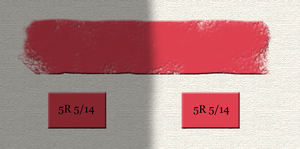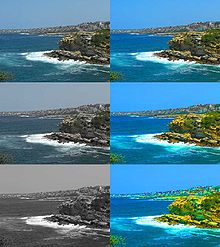Colorfulness
Perceived intensity of a specific color / From Wikipedia, the free encyclopedia
Dear Wikiwand AI, let's keep it short by simply answering these key questions:
Can you list the top facts and stats about Colorfulness?
Summarize this article for a 10 years old
Colorfulness, chroma and saturation are attributes of perceived color relating to chromatic intensity. As defined formally by the International Commission on Illumination (CIE) they respectively describe three different aspects of chromatic intensity, but the terms are often used loosely and interchangeably in contexts where these aspects are not clearly distinguished. The precise meanings of the terms vary by what other functions they are dependent on.
- Colorfulness is the "attribute of a visual perception according to which the perceived color of an area appears to be more or less chromatic (Any color that is absent of white, grey, or black)[clarification needed]".[1][2] The colorfulness evoked by an object depends not only on its spectral reflectance but also on the strength of the illumination, and increases with the latter unless the brightness is very high (Hunt effect).
- Chroma is the "colorfulness of an area judged as a proportion of the brightness of a similarly illuminated area that appears white or highly transmitting".[3][2] As a result, chroma is mostly only dependent on the spectral properties, and as such is seen to describe the object color.[4] It is how different from a grey of the same lightness such an object color appears to be.[5]
- Saturation is the "colorfulness of an area judged in proportion to its brightness",[6][2] which in effect is the perceived freedom from whitishness of the light coming from the area. An object with a given spectral reflectance exhibits approximately constant saturation for all levels of illumination, unless the brightness is very high.[7]




As colorfulness, chroma, and saturation are defined as attributes of perception, they can not be physically measured as such, but they can be quantified in relation to psychometric scales intended to be perceptually even—for example, the chroma scales of the Munsell system. While the chroma and lightness of an object are its colorfulness and brightness judged in proportion to the same thing ("the brightness of a similarly illuminated area that appears white or highly transmitting"), the saturation of the light coming from that object is in effect the chroma of the object judged in proportion to its lightness. On a Munsell hue page, lines of uniform saturation thus tend to radiate from near the black point, while lines of uniform chroma are vertical.[7]



